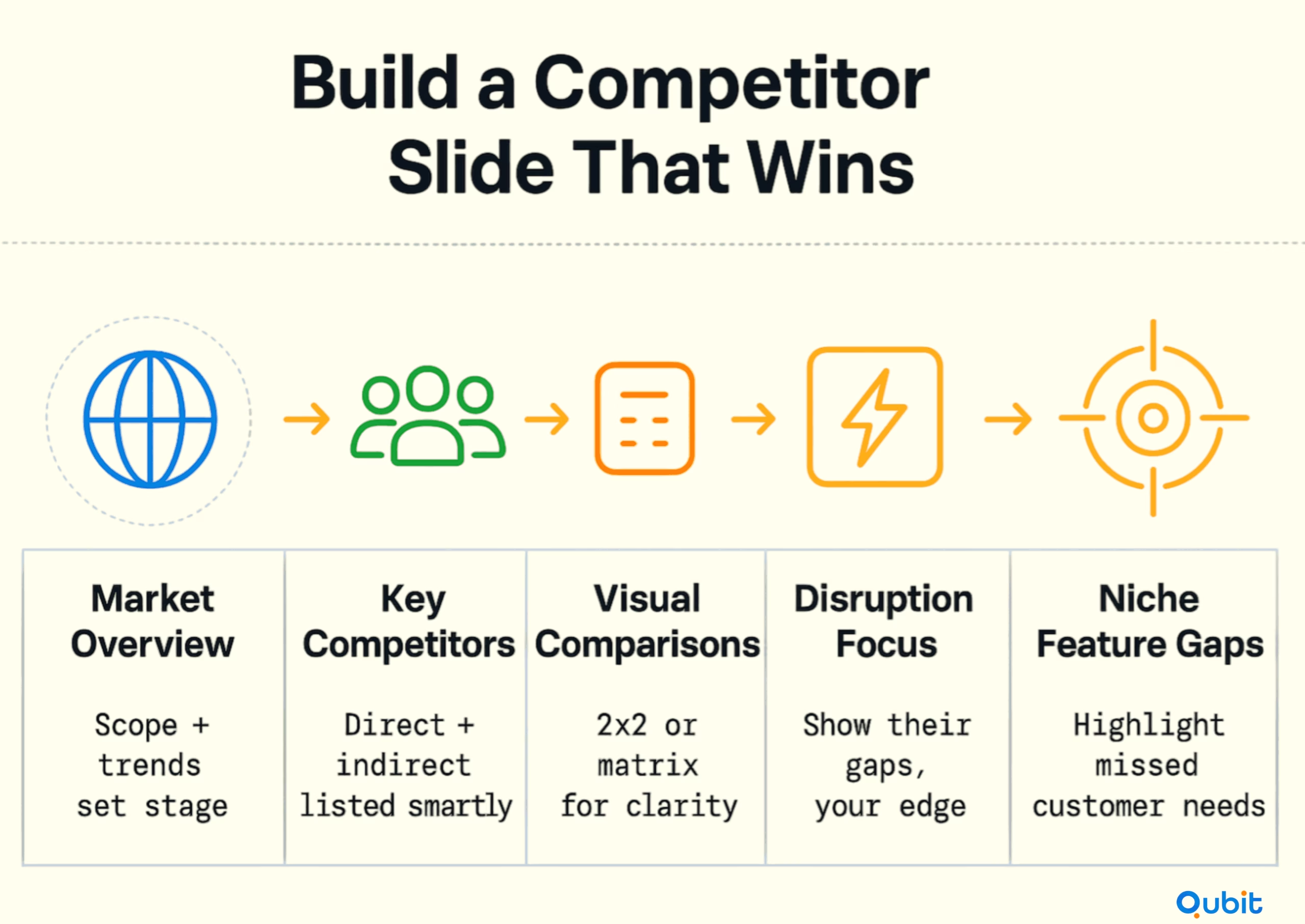A well-designed competition slide not only highlights your unique strengths but also demonstrates a clear understanding of the market landscape. For instance, tools like SlideModel allow you to create a 2×2 matrix that visually maps your position against rivals based on key differentiators. Similarly, Canva offers an intuitive platform for designing visually appealing slides, even for those without design expertise.
Whether you're showcasing your differentiators through visual comparisons or interactive elements, this section of your pitch deck can be a game-changer.
Let's get started!
Your Complete Guide to Building a Competitor Slide
Crafting a competitor slide is an essential part of any pitch deck, providing a clear snapshot of your market position and differentiation. Let's see how you can put up a impressive competitor slide using the tactics below:

1. Start with a Clear Market Overview
Begin by defining the scope of your market. Highlight the industry trends, customer needs, and the competitive dynamics that shape your business environment. This sets the stage for identifying your competitors and showcasing your unique value proposition.
For inspiration, refer to 11 Examples for a Better Competition Slide. These examples emphasize transparency about competitors and how your product stacks up against them.
2. Identify Key Competitors
Pinpoint the major players in your space. Focus on direct competitors offering similar products or services, as well as indirect competitors addressing the same customer pain points.
When listing competitors, describe their strengths and weaknesses. This approach ensures your audience understands the competitive landscape without feeling overwhelmed. For detailed guidance, check out Pitch Deck Competition Slide, which offers practical tips on structuring competitor lists effectively.
3. Use Visual Comparisons
Visual tools make your competitor slide more engaging and easier to digest. Consider using 2×2 grids, Venn diagrams, or feature matrices to illustrate your position relative to competitors.
For example, a 2×2 grid can highlight your unique strengths in terms of price, quality, or innovation. Alternatively, feature matrices can compare specific functionalities across products, helping investors quickly grasp your competitive edge. Explore How to Create a Differentiated Competitive Landscape Slide for specialized frameworks that enhance visual storytelling.
4. Assess Market Disruptions
Identify areas where your competitors may be vulnerable to disruption. This could include outdated business models, lack of innovation, or poor customer experience. Highlight how your product addresses these gaps and positions itself as a game-changer in the market.
For tactical recommendations on showcasing your product’s standout features, refer to How to Create a Killer Competition Slide. This resource emphasizes the importance of demonstrating how your strategy and benefits surpass those of your competitors.
5. Analyze Feature Gaps in Niche Segments
Dive deeper into niche segments within your market. Identify specific customer needs that competitors may have overlooked and explain how your product fills these gaps.
This analysis not only strengthens your competitive positioning but also highlights your ability to innovate and adapt to evolving market demands.
By following these steps, you’ll create a competitor slide that effectively communicates your market position, differentiators, and growth potential.
See How Competition Plays Out in Different Contexts
Competition is a universal force that shapes outcomes across diverse fields, from sports arenas to corporate boardrooms. Examining real-world competition examples reveals how this dynamic drives innovation, excellence, and survival in various environments.
Sports: The Thrill of Rivalry
Sports competitions are among the most visible examples of competitive dynamics. Whether it’s the Olympics or the FIFA World Cup, athletes push their limits to outperform rivals. These events showcase not only physical prowess but also strategic thinking, teamwork, and mental resilience. For instance, the intense rivalry between tennis legends Roger Federer and Rafael Nadal has captivated audiences for years, demonstrating how competition can elevate performance and redefine excellence.
Academic Contests: Fueling Intellectual Growth
In the academic world, competitions such as spelling bees, science fairs, and math Olympiads encourage participants to sharpen their skills and think creatively. These contests foster innovation and problem-solving abilities, preparing individuals for challenges beyond the classroom. The competitive spirit in academia often leads to groundbreaking discoveries and advancements that benefit society as a whole.
Business Rivalries: Driving Market Innovation

Corporate competition is a powerful catalyst for innovation and market growth. Iconic rivalries like Coca-Cola vs. Pepsi or Apple vs. Microsoft illustrate how businesses strive to outperform each other by improving products, enhancing customer experiences, and expanding market reach. These examples highlight the importance of understanding competitive dynamics when crafting strategies, such as creating a compelling market size slide for pitch deck to connect external examples to your total addressable market.
Nature: Survival of the Fittest
Competition isn’t limited to human endeavors; it’s deeply ingrained in the natural world. Animals compete for resources, territory, and mates, ensuring the survival of the strongest and most adaptable species. For example, the struggle between predators and prey showcases how competition drives evolution and ecological balance.
From the sports field to the natural world, competition examples underscore its universal relevance. Understanding these dynamics can inspire strategies in business, education, and beyond, helping individuals and organizations thrive in competitive environments.
Internal Link Integration:
Emphasizes how external examples connect to your total addressable market through the market size slide for pitch deck.
What You Need to Know About the Competition Overview Slide
A competition provides a snapshot of where your business stands in the market relative to competitors, offering clarity on your positioning and unique advantages. This slide is not just about listing competitors; it’s about showcasing your company’s strengths and strategic edge in a crowded marketplace.
Investors rely on this slide to quickly grasp the competitive dynamics of your industry. By presenting a clear comparison, you help them understand how your business differentiates itself and why it has the potential to succeed. Whether it’s through pricing, innovation, customer experience, or scalability, the competition overview slide highlights the factors that set your company apart.
The design and depth of this slide can vary depending on whether it’s part of a pitch deck or an investor deck. For instance, a pitch deck often requires concise, visually engaging content, while an investor deck may demand more detailed analysis. To better understand these differences, check out our guide on pitch deck vs investor deck, which helps shape how much detail or depth your overview slide should include.
A well-crafted competition overview slide typically includes:
- Market Positioning: A visual representation, such as a quadrant or chart, showing where your company stands in relation to competitors.
- Key Differentiators: Highlighting unique features, services, or strategies that give your business a competitive edge.
- Competitor Analysis: A brief comparison of competitors’ strengths and weaknesses, emphasizing areas where your company excels.
Ultimately, this slide is essential for building investor confidence. It demonstrates that you understand your market, have identified opportunities, and are prepared to capitalize on them. By presenting a clear and compelling competition overview, you position your business as a strong contender in its industry.
Unpack Competition in Ecosystem-Based Contexts
Competition in nature offers fascinating parallels to the business world. Ecosystems are dynamic arenas where species vie for survival, often competing for limited resources. Sharks, dolphins, and seabirds, for example, frequently clash over fish in shared waters. Each species employs unique strategies to secure its share, whether through speed, teamwork, or precision. These natural interactions provide valuable insights for businesses aiming to refine their competitive positioning.
Lessons from Nature: Ecosystem Competition Examples
Diverse Strategies for Shared Resources
Sharks rely on their speed and predatory instincts, dolphins use coordinated group tactics, and seabirds capitalize on their aerial vantage point to spot prey. Similarly, businesses must identify their strengths and tailor strategies to stand out in crowded markets. Whether it’s through innovation, collaboration, or niche targeting, understanding your unique advantage is key to thriving amidst competition.Adaptability in Changing Environments
Ecosystems are constantly evolving, forcing species to adapt or risk extinction. For instance, seabirds may shift their hunting grounds if fish populations migrate due to environmental changes. Businesses face similar challenges, such as shifting consumer preferences or emerging competitors. Crafting adaptable strategies ensures resilience in fluctuating market conditions.Collaboration vs. Competition
While sharks and dolphins compete for fish, dolphins often collaborate within their pods to maximize efficiency. This duality mirrors business dynamics, where companies may compete fiercely in some areas while forming strategic alliances in others. Recognizing when to compete and when to collaborate can unlock new opportunities for growth.
Applying Ecosystem Insights to Pitch Decks
When presenting a pitch deck, showcasing your competitive positioning is crucial. Drawing inspiration from natural ecosystems can help craft compelling slides that highlight your adaptability and unique strengths. For example, emphasizing how your business thrives in diverse conditions or collaborates effectively can resonate with investors.
To ensure your pitch deck is versatile enough to address complex competitive landscapes, explore the differences between pitch deck vs PitchBook. This comparison highlights the importance of adaptable slide designs tailored to diverse scenarios. By studying ecosystem competition examples, businesses can refine their strategies and create impactful presentations that resonate with stakeholders.
Conclusion
Crafting a compelling pitch deck is more than just assembling slides; it’s about telling a story that resonates with investors. Throughout this blog, we’ve explored actionable strategies, visual frameworks, and case studies designed to elevate your pitch deck’s impact. From clearly defining competitive positioning to structuring a narrative that captures attention, these insights are essential for creating a presentation that stands out.
A well-structured pitch deck not only communicates your vision but also builds confidence in your ability to execute it. By applying the tips shared here, you can transform your deck into a powerful tool for securing investor interest.
If you’re ready to refine your pitch deck and streamline investor communications, we at Qubit Capital are here to help. Explore our Investor Outreach Service to take your pitch deck to the next level. Let’s get started!
Key Takeaways
- A well-crafted competitor slide shows your market positioning at a glance.
- Step-by-step guidance helps you identify competitors and pinpoint market gaps.
- Drawing examples from sports, business, and nature offers fresh perspectives on competition.
- Visual frameworks—like 2×2 matrices and feature-comparison tables—enhance clarity and impact.
- A strategic competitor slide boosts investor engagement and improves funding prospects.
Frequently asked Questions
How to make a competitor slide?
Develop a step-by-step guide that outlines creating a market overview, identifying key competitors, and using visual tools. Incorporate real-world examples and available templates to reinforce your approach.


 Back
Back



